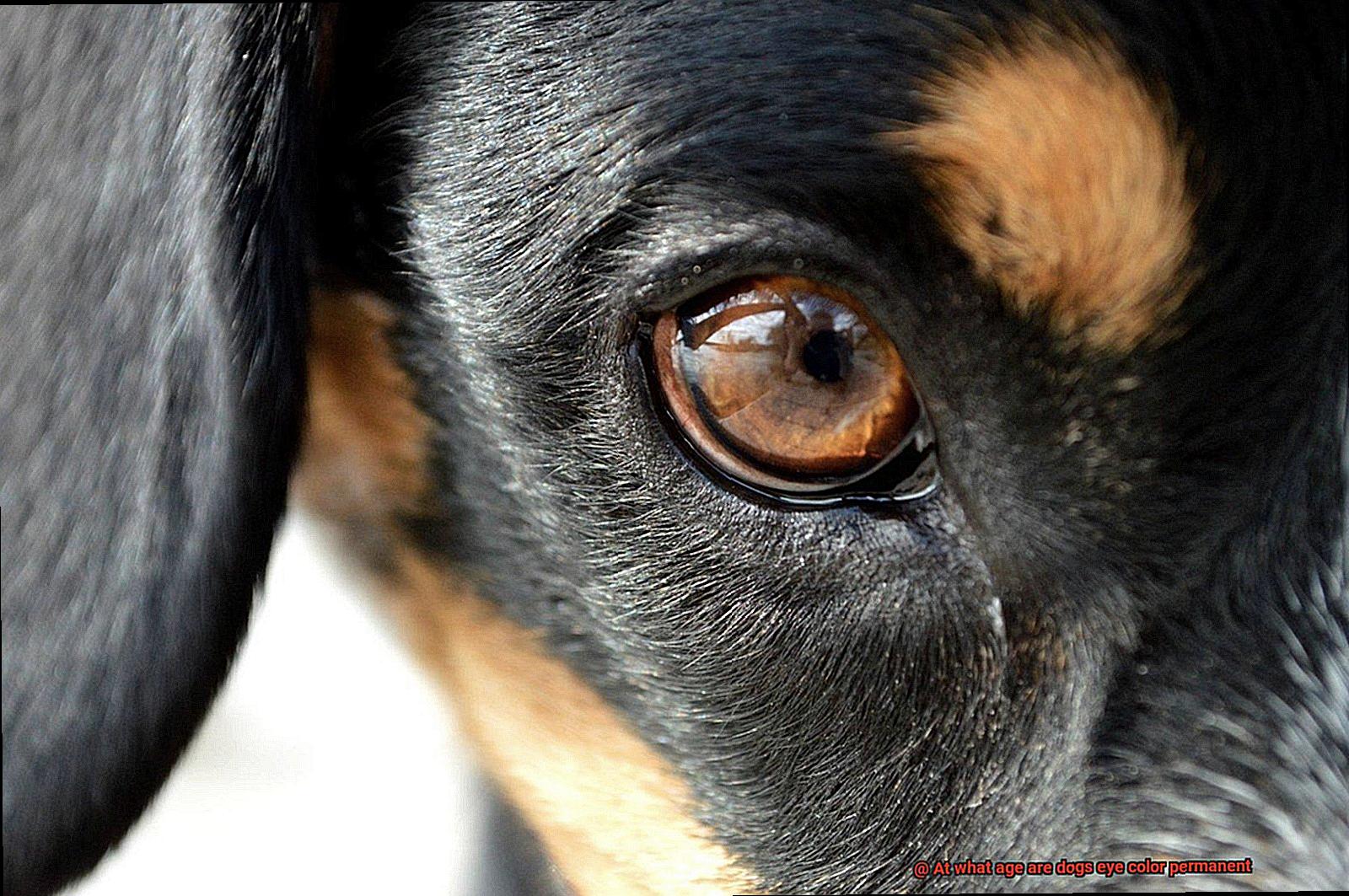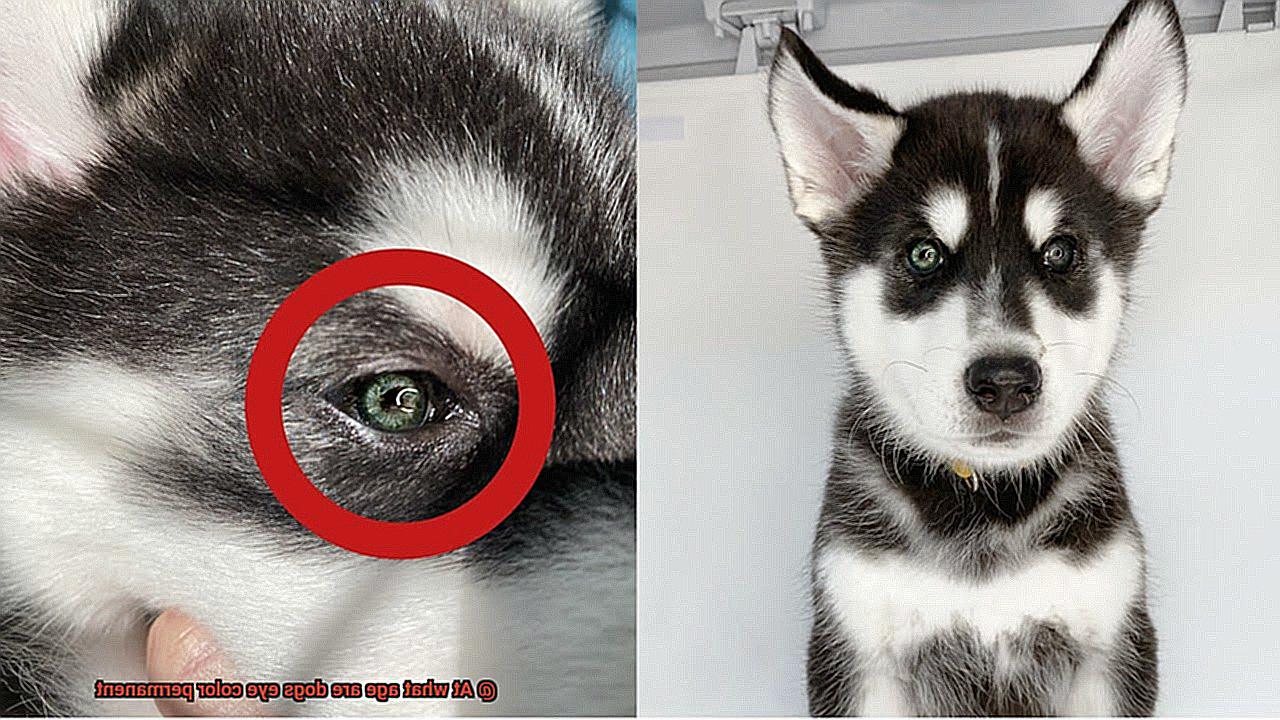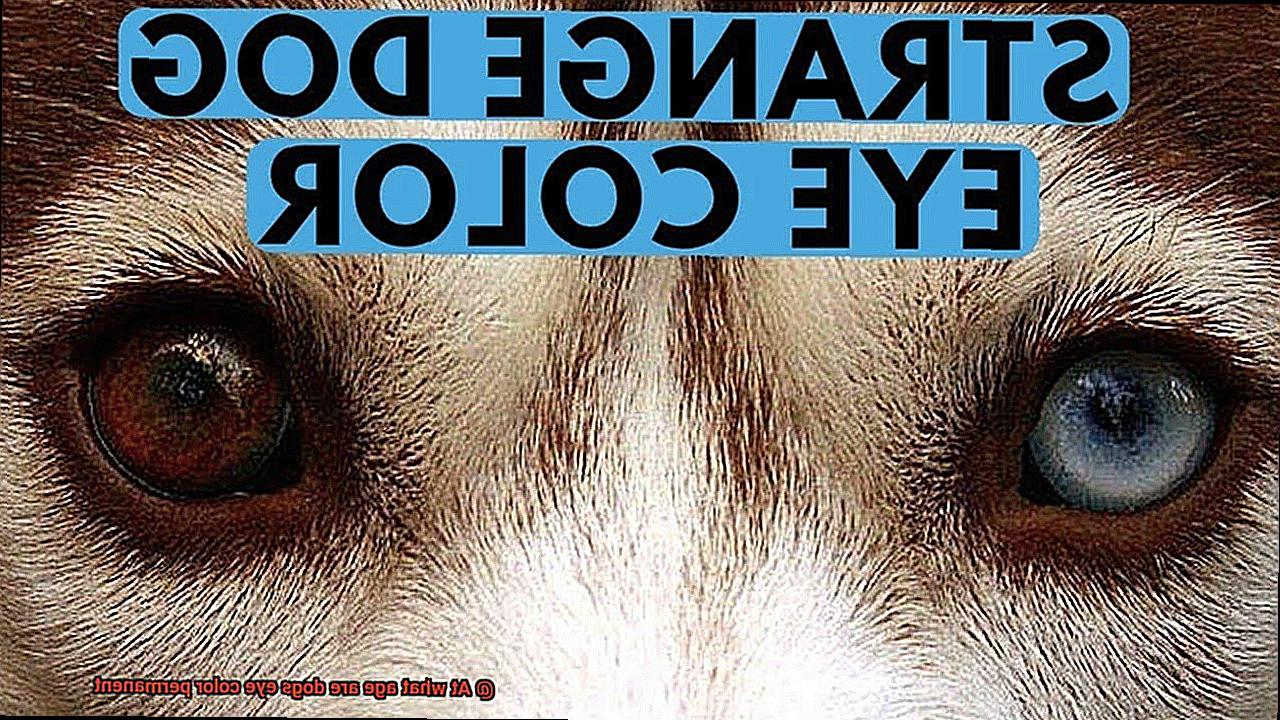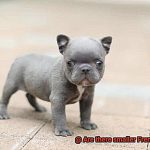At what age are dogs eye color permanent?
The enchanting gaze of our furry friends. Those soulful eyes can melt even the toughest of hearts. But have you ever wondered when your dog’s eye color becomes set in stone?
Puppies are known for their adorable blue or light-colored eyes, but here’s the scoop: those hues aren’t their final form. At around 6 to 8 weeks old, a puppy’s eye pigmentation is still a work in progress. It’s like they’re trying on different shades before settling on the perfect one.
Now, keep in mind that eye color development isn’t a one-size-fits-all situation. Each breed and individual dog has its own timeline. Usually, by the time a pup hits three months old, their eye color starts to stabilize. This means you’ll start seeing hints of what they’ll rock into adulthood.
But hold on tight because there’s more. Some puppies experience subtle changes even after three months. That once bright blue might deepen into hazel or transform into stunning amber tones. It’s like they’re playing with our hearts and keeping us guessing.
So remember, while we swoon over those puppy peepers from day one, their eye color journey doesn’t end there. It continues to evolve and surprise us as they grow up. It’s all part of what makes each dog unique and utterly captivating.

In this blog post, we’ll dig deeper into the factors that influence a dog’s eye color development. We’ll also explore some fascinating variations found in different breeds. Get ready to be amazed by how eyes can speak volumes even in our four-legged pals.

Disclaimer: Remember that results may vary based on breed, genetics, and individual dog development. Always consult with a veterinarian for specific information about your dog’s eye health and coloration.
At what age are dogs eye color permanent
Contents
- 1 At what age are dogs eye color permanent
- 2 Factors That Determine a Dog’s Eye Color
- 3 Puppies Have Blue Eyes at Birth
- 4 Most Dogs Have Permanent Eye Color by 8-12 Weeks Old
- 5 Some Breeds Retain Their Blue or Lighter-Colored Eyes into Adulthood
- 6 Age May Affect a Dog’s Eye Color
- 7 Health Conditions That Can Alter a Dog’s Eye Color
- 8 What to Do If Your Dog’s Eye Color Changes Suddenly or Dramatically
- 9 Conclusion
As an expert on this topic, I’m here to provide you with all the information you need.
When French Bulldog puppies are born, they typically have blue or grayish eyes. This is because their irises lack pigment at such a young age. However, as they grow and mature, the production of melanin in their eyes increases, leading to a change in eye color.
Around 6 to 8 weeks of age, you may start to see subtle changes in your French Bulldog’s eye color. This is when the process of eye color development begins. By the time your pup reaches 9 to 16 weeks old, their eye color may start to stabilize. However, it’s important to note that some changes can still occur during this time.
The final eye color of your French Bulldog is usually determined between the ages of 4 to 8 months. By this point, most dogs will have their permanent eye color. So, if you’ve been eagerly waiting to see what color your furry friend’s eyes will end up being, this is the time when you’ll finally know for sure.
While these timelines generally apply to most dog breeds, it’s essential to remember that certain breeds may have different eye color development patterns. For example, Siberian Huskies are known for their striking blue eyes, which can take longer to change or even remain blue throughout their lives. Additionally, some dogs may have heterochromia, where each eye has a different color. This can be seen in breeds like Australian Shepherds or Border Collies.
It’s also worth mentioning that certain health conditions or genetic factors can influence changes in eye color for dogs. If you notice any sudden or drastic changes in your French Bulldog’s eye color, it is always recommended to consult with a veterinarian.
Factors That Determine a Dog’s Eye Color
Have you ever wondered why some French Bulldogs have stunning blue eyes while others have rich brown eyes? Well, my curious friends, the color of a dog’s eyes is determined by a fascinating blend of factors. In this blog post, we’ll explore the genetic, breed-specific, age-related, and environmental influences that shape a French Bulldog’s eye color. So, grab a cup of coffee and get ready to dive deep into the world of canine eye hues.
Genetics: The Mastermind Behind Eye Color
When it comes to eye color in French Bulldogs (and all dogs, for that matter), genetics takes center stage. A dog’s eye color is determined by the genes that control the production and distribution of pigments in the eyes. While the precise genes responsible for eye color are still being unraveled by scientists, it is believed that multiple genes interact to create the beautiful spectrum of eye colors we see in different breeds.
Breed-Specific Traits: A Signature Look
French Bulldogs, like many other breeds, have certain eye color tendencies ingrained in their genetic makeup. While not all Frenchies will have the same eye color, certain patterns can be observed within the breed. Brown eyes are the most common among French Bulldogs, but some may also have hazel or even blue eyes. However, it’s important to note that blue-eyed French Bulldogs are not as common as in some other breeds like Siberian Huskies.
Age: A Journey of Transformation
Just like humans, French Bulldog puppies are often born with baby blues or grayish eyes. This is because their irises don’t yet contain enough pigment to reveal their true eye color. As they grow older, typically between 6 to 8 weeks of age, their eyes start to undergo a mesmerizing transformation. Gradually, their true eye color emerges and stabilizes, usually by 9 to 16 weeks old. So, if you’re anxiously waiting for your Frenchie’s eye color to settle, be patient and enjoy the enchanting journey.
Environmental Influences: A Subtle Touch
While genetics primarily dictate a French Bulldog’s eye color, environmental factors can play a minor role in influencing pigmentation. Sunlight exposure, certain medications, and illnesses may cause subtle changes in eye color over time. However, these changes are usually minimal and do not drastically alter the overall eye color.
Puppies Have Blue Eyes at Birth
It’s true. Let’s find out why.
- The Story Behind the Blue: At birth, puppies’ pigment-producing cells, called melanocytes, are not fully developed. These cells are responsible for producing the pigments that give color to their irises. Since the melanocytes are still growing, the puppies’ eyes lack enough pigment to display any other color than blue.
- Light and Reflection: The blue color that you see in your French Bulldog puppy’s eyes is a result of light scattering. The structure of their irises is not fully formed yet, so they can’t absorb certain wavelengths of light. Instead, shorter blue wavelengths scatter and reflect back, creating that adorable blue-eyed look.
- Changing Colors: As your puppy grows and develops, their melanocytes start producing more pigments. This gradual increase in pigmentation leads to a change in eye color. The process of eye color change is influenced by genetics and the type and amount of pigments produced by the melanocytes.
- Timing is Everything: While each puppy is unique, most French Bulldog puppies’ eye colors start to change around 6 to 8 weeks of age. By 9 to 12 weeks old, their eye color has usually stabilized, revealing their true eye color. However, keep in mind that slight variations or subtle changes can still occur even after this stage.
- The Final Reveal: The adult eye color of your French Bulldog is determined by the distribution and amount of different pigments in their irises. From shades of brown to green, hazel, amber, or even blue in some breeds, their eye color will ultimately reflect their unique genetic makeup.
Remember, eye color change is a natural process that cannot be controlled or influenced. The best way to predict your French Bulldog puppy’s eventual eye color is by observing any changes during their early months. However, if you notice any concerning or unusual changes in their eyes, it’s always a good idea to consult with your veterinarian.
Most Dogs Have Permanent Eye Color by 8-12 Weeks Old
Have you ever wondered when your adorable French Bulldog puppy’s eye color will settle? Well, you’re in luck. In this article, we’ll dive into the fascinating world of dog eye colors and why most dogs, including French Bulldogs, have their permanent eye color by 8-12 weeks old.
The Development of Eye Color in Puppies
Just like human babies, puppies are born with their eyes closed. It takes a few weeks for their eyes to fully develop and open. During this time, their irises, which determine their eye color, are not fully developed. That’s why you may notice a hazy blue or grayish color in their eyes during the first few weeks of life.
As the puppies grow, their irises start producing more pigment, gradually changing the color of their eyes. The amount and type of pigment produced play a significant role in determining the final eye color. By around 8-12 weeks of age, most puppies will have their permanent eye color established.
Genetics: The Key Player
Genetics play a crucial role in determining a dog’s eye color. The genes inherited from the parents can influence whether a puppy’s eye color will change or remain the same as they mature. It is important to note that not all dogs’ eye colors will change during this time frame. Some puppies may have their permanent eye color established at a younger age, while others may take a bit longer.
French Bulldogs and Eye Colors
Now let’s talk specifically about French Bulldogs and their eye colors. Many French Bulldogs have dark brown eyes, which are the most common eye color for this breed. However, variations such as hazel or blue eyes are also possible. It’s important to embrace the uniqueness in each dog’s appearance and not judge them solely based on their eye color.
What if the Eye Color Doesn’t Stabilize?
In most cases, a puppy’s eye color will stabilize by 8-12 weeks of age. However, if you notice that your French Bulldog’s eye color is not settling within the expected time frame, it’s advisable to consult with a veterinarian. There could be underlying health issues or genetic factors causing the delay in eye color development.
Remember, Eye Color Isn’t Everything
While eye color can be mesmerizing and captivating, it’s essential to understand that eye color alone does not indicate the overall health or quality of a dog. When assessing your French Bulldog’s well-being, consider other aspects of their appearance and behavior alongside their eye color.
Some Breeds Retain Their Blue or Lighter-Colored Eyes into Adulthood
French Bulldogs are known for their adorable appearance, and one feature that captures the hearts of many is their beautiful eye color. While most puppies are born with blue eyes that eventually change to a darker shade as they mature, some breeds, including French Bulldogs, have a genetic trait that allows them to retain their blue or lighter-colored eyes into adulthood.
The Merle Gene and Eye Color
In breeds such as the Siberian Husky, Australian Shepherd, Border Collie, and Dalmatian, the eye color is determined by the presence of a gene called the “merle” gene. This gene is responsible for diluting the pigment in the iris, resulting in blue or lighter-colored eyes. French Bulldogs can also carry the merle gene, which is why some individuals within this breed may retain their blue or lighter-colored eyes.
Age at Which Eye Color Stabilizes
While most dogs’ eye color stabilizes by 12 to 16 weeks old, some breeds may take longer for their eye color to fully develop. French Bulldogs fall into this category, and it is not uncommon for their eye color to reach permanence around 6 to 9 months of age. It’s important to note that even if a French Bulldog has blue or lighter-colored eyes as a puppy, there is no guarantee that their eyes will remain that way into adulthood. Some dogs may experience a gradual change in eye color as they grow older, especially if they have darker pigmentation in their genes.
Factors Affecting Eye Color
Several factors can influence a dog’s eye color development. Genetics play a significant role, but environmental factors can also contribute. For example, exposure to sunlight can darken the pigmentation in the iris over time. Additionally, certain health conditions or eye injuries can affect eye color. It is essential to monitor any changes in your French Bulldog’s eye color and consult with a veterinarian if you have any concerns.
Age May Affect a Dog’s Eye Color
If you’re the proud owner of a French Bulldog, you may have noticed that their eye color is one of their most striking features. Those beautiful blue or lighter-colored eyes can be quite captivating.
But did you know that age can play a role in your Frenchie’s eye color?
Puppyhood: The Blue-Eyed Stage
Like many other dog breeds, French Bulldog puppies are born with blue eyes. This is true regardless of the eventual eye color they will develop. So, if you’ve recently welcomed a Frenchie puppy into your home, don’t be surprised by those adorable blue peepers.
The Melanin Development
As your Frenchie puppy grows older, their eye color may start to change. This is because the melanin in their eyes begins to develop. Melanin is the pigment that gives color to the eyes, hair, and skin. As more melanin is produced, the eye color can shift.
The Age of Transformation
Typically, the process of eye color change occurs between the ages of 6 to 16 weeks for most puppies. By around 9 to 12 weeks old, you may start to see their true eye color becoming more apparent. However, it’s important to note that some puppies’ eye colors continue changing until they reach adulthood.
Genetics and Eye Color
Genetics also play a significant role in determining a dog’s eye color. Different genes control the production of melanin, which ultimately determines the eye color. French Bulldogs with the “merle” gene may have lighter-colored eyes that remain blue into adulthood.
Environmental Influences
While genetics are a major factor in eye color development, environmental influences can also play a part. Exposure to sunlight can affect the pigmentation of the iris and potentially alter the eye color over time. It’s essential to protect your Frenchie’s eyes from excessive sun exposure to maintain their eye color.
Embracing the Changes
It’s important to remember that eye color changes are a normal part of your Frenchie’s development. Some dogs may have permanent eye color by around 16 weeks old, while others may continue to experience subtle changes throughout their lifetime. Embrace these changes and enjoy the unique beauty of your furry companion.
Health Conditions That Can Alter a Dog’s Eye Color
Today, we’re going to dive into the fascinating topic of health conditions that can cause a change in your Frenchie’s eye color. As responsible dog owners, it’s crucial to be aware of these conditions and how they can affect our furry friends’ precious peepers. So, let’s get started.
Heterochromia: The Mismatched Marvel
One common condition is heterochromia, where one or both eyes have different colors. Whether your Frenchie was born with it or developed it later in life, heterochromia can be caused by genetics, injuries, or medical conditions like pigmentary glaucoma or uveitis. It’s like having a fashion-forward pup with mismatched shoes.
Pigmentary Glaucoma: Pressure Problems
Imagine this – your Frenchie’s eye color darkening or taking on a bluish-gray appearance. This could be a sign of pigmentary glaucoma, a condition that affects the eye’s drainage system. Increased pressure and optic nerve damage can lead to these eye color changes, along with symptoms like redness, pain, and vision problems. Time to call the doggy ophthalmologist.
Uveitis: Inflammation Invasion
When the middle layer of your Frenchie’s eye called the uvea becomes inflamed, it’s called uveitis. Infections, autoimmune disorders, or eye trauma can trigger this condition. Alongside changes in eye color caused by inflammation and iris damage, your pooch may experience discomfort and other vision issues. Time for a vet visit to tackle this inflammation invasion.
Cataracts: The Cloudy Culprits
Cataracts can also play a role in altering your Frenchie’s eye color. These cloudy villains form when the lens of the eye loses transparency. If you notice a cloudy or whitish-gray appearance in your pup’s eye, cataracts could be to blame. Talk to your vet about options to restore transparency and bring back the original eye color.
Medications: The Color Changers
Believe it or not, certain medications can also cause changes in your Frenchie’s eye color. Long-term use of antibiotics or steroids may lead to drug-induced cataracts and other vision problems, resulting in altered eye colors. Keep an eye out for any changes and consult your vet if you suspect medication side effects.
Stay Vigilant and Seek Veterinary Care
Remember, it’s essential to monitor your Frenchie’s eye color and seek veterinary attention if you notice any changes or abnormalities. Your veterinarian will be able to determine the underlying cause of the color change and recommend appropriate treatment. Early detection and treatment can make all the difference in your furry friend’s eye health.
What to Do If Your Dog’s Eye Color Changes Suddenly or Dramatically
If you are a proud owner of a French Bulldog, you know that their adorable squishy faces and expressive eyes are part of their charm. But what should you do if you notice a sudden or dramatic change in your Frenchie’s eye color? In this article, we will explore the possible reasons for such changes and provide guidance on what steps to take.
Understanding Normal Eye Changes in Dogs
Dogs’ eye colors can change gradually as they age, but sudden or dramatic changes can be a cause for concern. It is important to note that some breeds, like Siberian Huskies or Australian Shepherds, commonly have eyes that change color as they mature. These changes are usually due to genetics and are considered normal. However, if you own a French Bulldog, sudden changes in eye color may require further investigation.
Potential Health Issues
One possible reason for a sudden change in eye color is the presence of an underlying health issue. Conditions such as glaucoma or uveitis can cause inflammation in the iris, resulting in a change in eye color. If you notice a sudden change in your Frenchie’s eye color, it is crucial to have them examined by a veterinarian to rule out any potential health problems.
Trauma or Injury
Another possible cause of a sudden change in eye color is trauma or injury to the eye. If your French Bulldog has recently been involved in an accident or has experienced any type of trauma to the eye, it could lead to changes in the appearance of their eyes. Seeking immediate veterinary attention is crucial to prevent further damage and ensure proper treatment.
Medication or Treatment Effects
Certain medications or treatments can also affect a dog’s eye color temporarily. For example, topical ointments or medications used to treat eye infections or allergies may alter the appearance of the eyes. However, these changes are usually temporary and will revert back to their original color once the treatment is discontinued.
Consult with a Veterinarian
If your French Bulldog’s eye color changes suddenly or dramatically, and there are no apparent health issues or injuries involved, it is still advisable to consult with a veterinarian. They can perform a thorough examination and provide guidance on whether further investigation or monitoring is necessary.
Z1NeaQk__cU” >
Conclusion
Determining when a dog’s eye color becomes permanent is a topic of curiosity for many pet owners. While it varies from breed to breed and even within individual dogs, there are some general guidelines to consider. Typically, a puppy’s eye color starts to change around six to eight weeks of age. However, it can take several months for the final hue to settle in. During this time, it’s not uncommon for puppies’ eyes to go through various shades and colors, adding an element of mystery and excitement to the process.
As the weeks go by, you may notice your pup’s eyes transitioning from their initial blue or gray shade to a more definitive color, such as brown, green, or hazel. This transformation occurs due to the development of pigmentation in the iris. The amount and type of pigment present determine the ultimate eye color.
It’s important to note that certain breeds have specific patterns when it comes to eye color changes. For instance, Siberian Huskies often have striking blue eyes as puppies but may develop different shades as they mature. Australian Shepherds commonly exhibit heterochromia, where each eye has a different color or variation in pigmentation.
While most dogs’ eye colors become permanent by six to nine months of age, some individuals may experience slight variations throughout their lives. Factors such as genetics and environmental influences can play a role in these subtle changes. However, once your furry friend reaches adulthood, any further alterations are typically minimal.
Understanding when your dog’s eye color becomes permanent can be both fascinating and helpful for breeders and owners alike. It allows us to appreciate the unique beauty our pets possess and provides insight into their genetic heritage.




